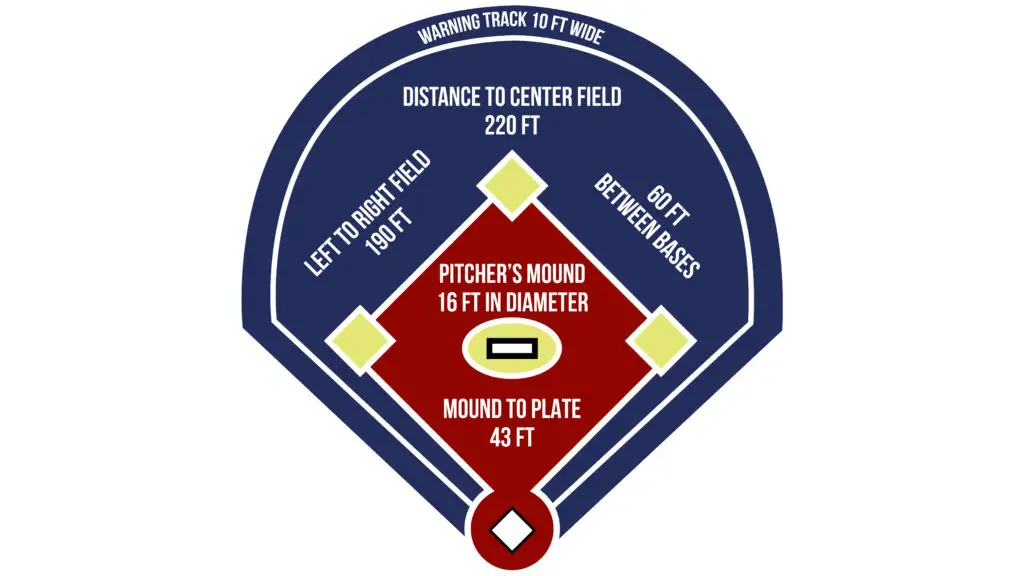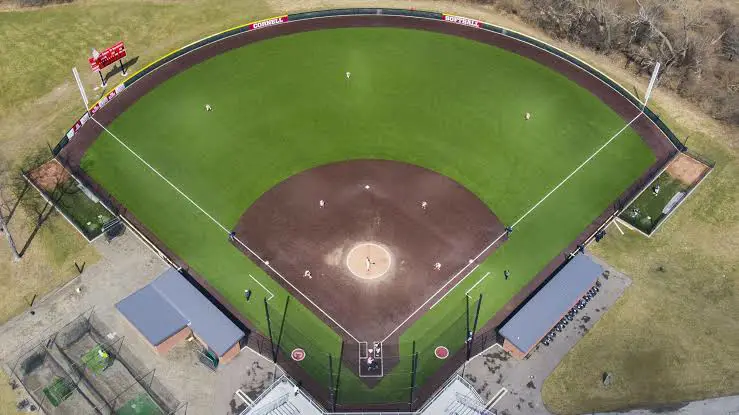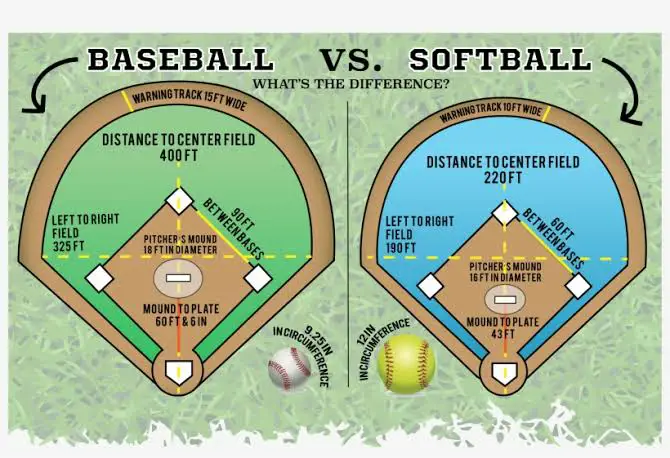Softball diamonds tend to be uniquely designed. One field’s grass may be quite different from that of another. Different fields may have slightly different foul line lengths. However, for a field to be utilized in a regulation game of softball at the high school or collegiate level, it must conform to the standards for field dimensions established by the International Softball Federation. These standard measurements help make every field the same and fair. In this article, we will look at the various softball field dimensions.

How Big Is A Softball Field?
The standard dimensions for a softball field are 300 x 150 feet. This is the normal size; however, it might vary significantly from league to league.

Important Points on Softball Field Dimensions
The standard size for a softball field dimensions is 300 feet around.
Usually, a softball field will have a dirt infield and a grass outfield.
A softball field has four bases in a midfield diamond.
In softball, the pitcher stands on a mound 60 feet from home plate in the center of the diamond.
A softball normally has a permanent fence 8-10 feet above the perimeter.
There is a lot of crossover between a baseball field dimensions and a softball field. The field is much bigger, which is the primary distinction. Most baseball fields are larger than softball fields. Additionally, the distance between home plate and the outfield barrier has shrunk.
Part of a softball field
Accurate softball field measurements require familiarity with the terminology used in the field and by the international softball federation. An expansive softball field is divided up into numerous sections. They all have very particular places in relation to one another, so you should learn about each before pulling out the ruler. You may already be familiar with the field if you’re a softball player. Review these items as a reminder. Use this checklist to get ready for the game’s precise dimensions and specifications, even if you’ve never played before.
Home plate
Home plate is one of the popular positions in softball. A player’s goal after rounding the bases is to touch home plate with the ball. The pitcher will toss the ball over the plate when a batter is at the plate.
Bases
The softball field has three bases: first, second, and third. Players will attempt to return to home plate by running the bases after each at-bat. There will always be players on or near the bases because these are safe zones. The pitcher’s circle is in the center of the diamond, and the three bases form a triangle around it.
Batter’s boxes
When players are at bat, they stand in this area close to home plate. A chalk batter’s box has been drawn on the ground on both sides of home plate. This allows both right- and left-handed hitters an equal opportunity at the plate.
The backstop
The backstop is the fencing behind home plate that deflect balls back onto the field and away from the stands.
Softball Pitcher’s circle
Pitchers typically take their positions in the center of the infield. This is the pitcher’s mound where the pitchers stand.
Pitcher’s rubber
The rubber rectangle serves as the pitcher’s stance on the mound.
Baselines
Softball bases are 60 feet apart. The perfect square of the distance from home plate to second base and the corner of first base to the corner of third base is 84 feet, 10 and a quarter inches. The baseline is 25 feet distance from the back of the home plate.
The baselines link home plate and the bases. This makes the four bases into the classic diamond form associated with baseball and softball.
Infield
The infield is the grassy space inside the diamond and the dirt between the bases.
Outfield
Beyond the infield is a grassy area. It goes all the way to the permanent outfield fence.
Foul lines
Lines drawn in foul territory extend the baselines from home to first and third base to first. If the batter hits the ball outside these lines, it is a foul ball.
Foul poles
Tall poles like this denote where the foul lines meet the outfield fence. They allow players to quickly and easily determine if a ball soared over the fence is fair.
Outfield fencing
At the very edge of the outfield, you’ll find the fencing. It’s there to show where the playing field stops. A home run is recorded when a batter hits a ball over the outfield fence.
Softball Field Perimeter Dimensions
Setting out the perimeter of the softball field is the final step in developing a field with the appropriate proportions. The areas of the softball field that are not part of the diamond, infield, or outfield make up what is known as the perimeter. If a batter hits the ball into any of these places, it will be ruled a foul ball. However, the opposing side still has a chance to catch the ball before it touches the ground, resulting in an out. For such activities to take place around the perimeter, sufficient space must be available. The following information pertains to the perimeter of the softball field:
Backstop to home plate
Both high school and college softball fields should have a distance of 25 feet between the backstop and the bottom tip of the home plate. This distance should be consistent. This provides a sufficient amount of playing space for catchers, allowing them to make plays on errant balls, catch a ball from another player, and move about as necessary.
Foul lines
The zones where fair hits can be made and the sections where the hitter can only make the foul lines separate foul hits. They run down the left and right baselines, beginning at the bottom edge of home plate. They stretch into the outfield and end where the foul poles are located, intersecting with the outfield railing.
Foul lines to the nearest obstruction
You must provide ample space for softball players to execute moves in response to foul balls safely. The National Federation of State High School Associations (NFHS) and the National Collegiate Athletic Association (NCAA) both propose that a spacing of 25 to 30 feet be left between the foul lines and the nearest barrier. Walls, fencing, or even the audience stands themselves could constitute obstructions. Players in softball make use of these regions to catch fly balls and force outs for their team against the other team.
And with that, you have all the measures necessary to design a softball field that complies with the high school and college regulations. After you have finished constructing the field, your next priority should be to ensure that everyone who utilizes the field does so in a safe manner.
College Softball Field Diamond Dimensions
To host collegiate softball games, your field must conform to the following standards:
Home plate to first and third bases
These two lanes should be 60 feet in width, measured from the back of the home plate to the base.
Home plate to second
The measurement from the tip of the house at the back to the bottom should be exactly 84 feet, 10 inches.
Distance between bases
The distance between home and second bases should be 60 feet.
Home plate to the front of the pitching rubber
It should be 43 feet from the back of the home plate to the center of the pitching rubber.
Pitcher’s circle
Like the high school pitcher’s circle, this one should have a radius of 8 feet.
Infield arc
Beginning at the middle of the home plate, this arc should extend to a distance of 60 feet.
Frequently Asked Questions
What is the difference between softball field dimensions and baseball field?

When compared to a baseball field, softball fields are considerably more compact. The distance from home plate to first base is 90 feet on a baseball field, but it is just 60 feet on a softball field. A softball field has bases placed 70 feet apart rather than 90 feet on a baseball diamond. Finally, compared to a baseball game, softball uses an outfield that is roughly twice as large (325 feet vs. 150-200 feet).
The softball field is so small—why?
Since softball is less difficult to hit and does not travel as far as baseball, the softball field is significantly smaller.
In softball, how far is a home run?
The answer to this question depends on the softball competition you participate in. A home run in softball at the collegiate or professional level is typically defined as a hit that goes beyond the outfield fence. For instance, a home run in Little League is considered a hit if it goes beyond the outfield fence.
